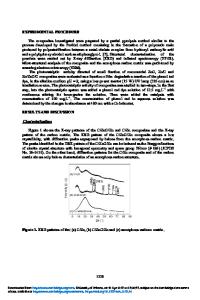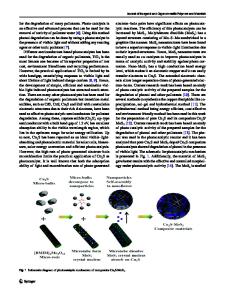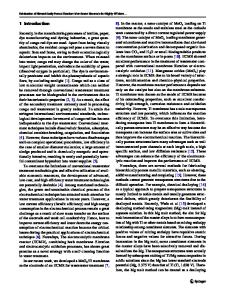Efficient porous carbon/CdS composite photocatalyst for dye degradation
- PDF / 1,696,593 Bytes
- 10 Pages / 595.276 x 790.866 pts Page_size
- 40 Downloads / 417 Views
Efficient porous carbon/CdS composite photocatalyst for dye degradation Liangxing Zhang1, Linsen Huang1, Xiaoqing Jiang1, Junhua Li1, and Xiaosong Sun1,*
1
Sichuan University, School of Materials Science and Engineering, No. 24 South Section 1, Yihuan Road, Chengdu 610065, China
Received: 7 August 2020
ABSTRACT
Accepted: 28 October 2020
This very paper focuses on the preparation of an eco-friendly and efficient photocatalyst aiming to degrade organic dyes in wastewater. The cheap and abundant straws were carbonized to prepare porous carbon pieces in this study. A simple hydrothermal method was employed to prepare the porous carbon/ CdS (PC/CdS) composite. CdS nanoparticles were anchored on these porous carbon sheets, forming the PC/CdS composite. The composite was annealed at 300, 400, and 600 °C, respectively, and then these samples were characterized by SEM, TEM, XRD, and FTIR. As an important parameter, the porosities of PC and the PC/CdS were characterized by BET method. Particularly, the photo-electronic response of PC/CdS has been characterized by EIS, PL, and transient photocurrent. It is found that the carrier mobility and shape of PC itself and the annealing process improved the photocatalytic activity, as well as adsorption ability. Those composites were able to thoroughly degrade RhB within 90 min under the irradiation of visible light. What is interesting and quite different from other reports is that there was no conjugated part of RhB left in the solution after photocatalytic degradation.
Ó
Springer Science+Business
Media, LLC, part of Springer Nature 2020
1 Introduction A huge amount of apparel is produced, purchased, and discarded everyday around the world, which drastically boosts the development of clothing industry. However, clothing industry is not ecofriendly, as a great deal of printing and dying wastewater, which is resistant to the biodegradation procedure and even carcinogenic [1], was drained out. Thus, some techniques are needed to destroy or
Address correspondence to E-mail: [email protected]
https://doi.org/10.1007/s10854-020-04784-8
to remove the residual dyes from the wastewater. Activated carbon fiber (ACF) was used to electrochemically degrade or to adsorb dyes from wastewater [2–5]. Nevertheless, extracting dyes from wastewater via adsorption is probable to cause secondary pollution if the sorbent is not treated properly while degrading dyes via electrochemical method consumes too much energy. To purify wastewater, photocatalysis is now highly regarded [6–8]. Some metal oxide/sulfide semiconductors are utilized for this goal. For instance, TiO2 works well in
J Mater Sci: Mater Electron
photocatalysis under the irradiation of UV with the assistance of H2O2 [9]. ZnO is another widely studied and applied photocatalyst, as it does not need H2O2 [10]. However, semiconductors like TiO2 and ZnO can hardly work under visible light as their bandgap is so big that they hardly harvest the photon of visible light. CdS is a fascinating photocatalyst with good sunlight harvesting
Data Loading...











